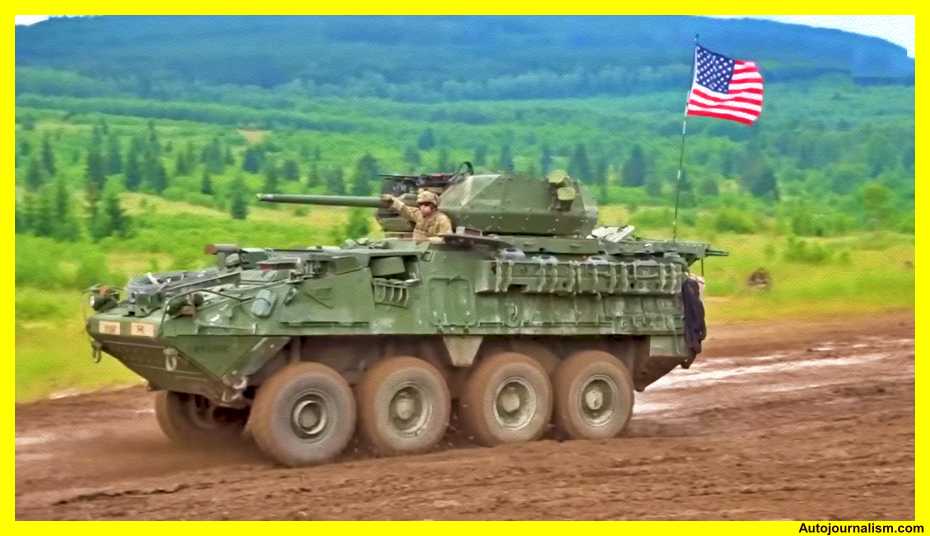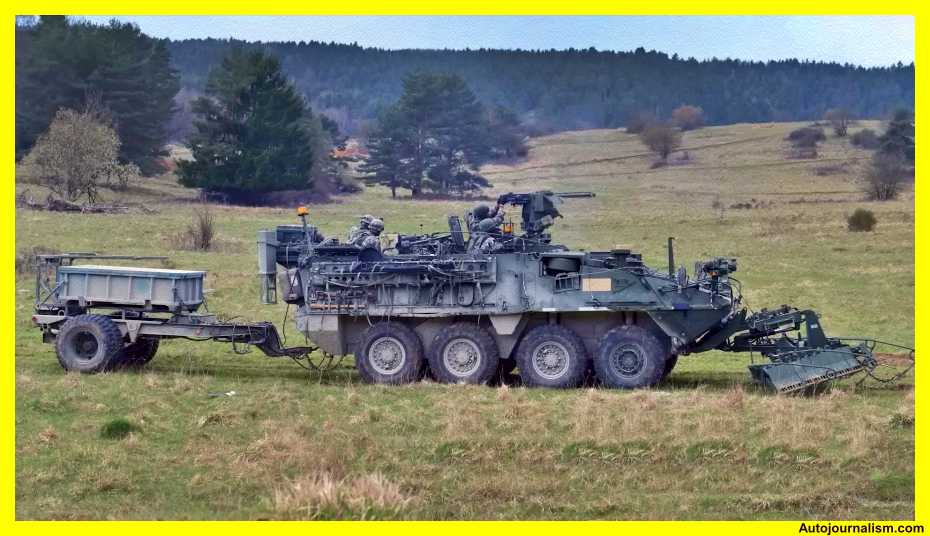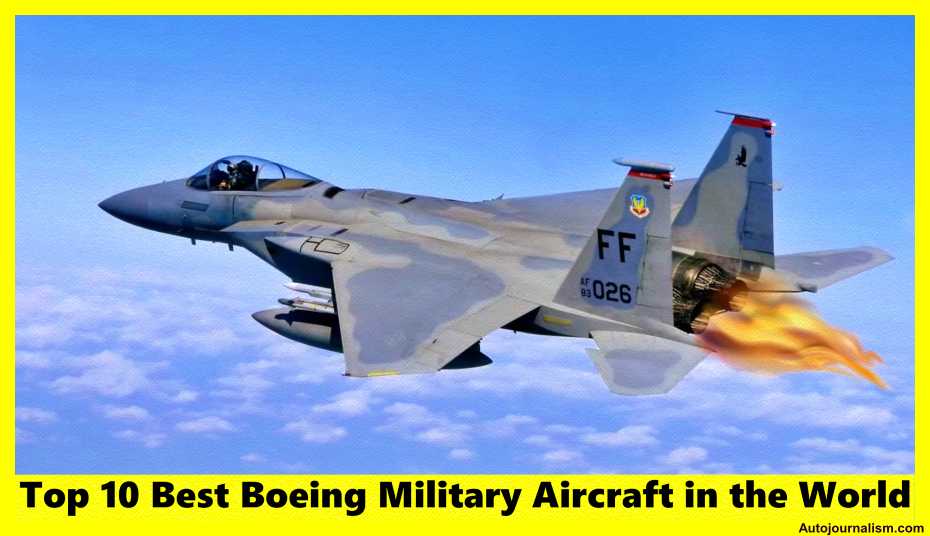Top 10 Stryker Armored Vehicles in the World
Today we will give you the list of the Top 10 Stryker Armored Vehicles in the World with Images, and Details and you can Download this Page as a PDF in 1 click, just go to the end of this Page, So let’s Start.
- The Stryker Armored Combat Vehicle Family stands as a testament to innovation and versatility in modern military technology. Developed by General Dynamics Land Systems, the Stryker family includes a variety of variants designed to fulfill specific roles on the battlefield. From infantry transport to reconnaissance and heavy firepower, the Stryker family has proven its worth in various theaters of operation. In this article, we will explore the top 10 Stryker armored vehicles in the world, each tailored for distinct combat scenarios.
Top 10 Stryker Armored Vehicles in the World
Stryker armored vehicles have become synonymous with versatility, mobility, and firepower on the modern battlefield. Developed by General Dynamics Land Systems, the Stryker family of vehicles has evolved to meet the diverse operational needs of military forces worldwide. In this article, we will explore the top 10 Stryker armored vehicles, highlighting their unique features and capabilities that make them stand out on the global stage.
#1. M1126 Infantry Carrier Vehicle (ICV)
The M1126 ICV is the cornerstone of the Stryker family, designed to transport infantry quickly and safely into the heart of the battle. It features advanced communication systems, enhanced survivability, and the ability to carry a squad of infantry with their equipment.
| Specification | M1126 Infantry Carrier Vehicle (ICV) |
|---|---|
| Drive Configuration | A 4-wheel drive (8×4) that can be switched to an all-wheel drive (8×8) (Armored Personnel Carrier – Infantry Fighting Vehicle Hybrid) |
| Engine | 350 hp Caterpillar C7 engine |
| Mounted Weapon | M2 .50 cal. machine gun or MK19 40mm grenade launcher (in Protector RWS) |
| Crew | 2 |
| Range | 300 miles |
| Speed | 62 mph |
| Armament | M2 12.7 mm heavy machine gun or 40 mm automatic grenade launcher |
| Weapon Station | Remotely-controlled weapon station |
| Origin | Derived from Canadian LAV III/Swiss MOWAG Piranha IIIH 8×8 |
| Producer | General Dynamics Land Systems for the United States Army |
- The M1126 Infantry Carrier Vehicle (ICV) is a versatile armored personnel carrier used by the United States Army and the Royal Thai Army. Part of the Stryker family, it offers a blend of mobility, firepower, and adaptability for various combat scenarios. Derived from the Canadian LAV III/Swiss MOWAG Piranha IIIH 8×8, the M1126 ICV is produced by General Dynamics Land Systems.
- It can be configured for 4-wheel drive (8×4) or switched to an all-wheel drive (8×8), with a 350 hp Caterpillar C7 engine, making it a mobile and robust platform. Equipped with a remotely-controlled weapon station, it can carry an M2 .50 cal. machine gun or MK19 40mm grenade launcher. With a range of 300 miles and a speed of 62 mph, the M1126 ICV is a key asset for infantry transport and support.
#2. M1134 Anti-Tank Guided Missile (ATGM)
This variant of the Stryker is equipped with the TOW missile system, providing long-range anti-tank capabilities. The M1134 plays a crucial role in countering armored threats on the battlefield.
| Specification | M1134 Stryker Anti-Tank Guided Missile (ATGM) Vehicle |
|---|---|
| Type | Armored fighting vehicle |
| Usage | Primary tank destroyer system of the US Army’s Stryker Brigade Combat Team |
| Crew | 4 |
| Armament | Elevated twin TOW anti-tank guided missile system with 12 missiles |
| Missile Type | TOW 2 heavy anti-tank guided missiles, compatible with older TOW missiles |
| Launcher Configuration | Two-tube launcher with an elevated mast extending 0.5 meters above the chassis |
| Speed | Up to 100 km/h |
| Range | 500 km |
| Engine | Caterpillar turbocharged diesel engine (350 hp) |
| Integration | Used in separate anti-tank companies of Stryker brigades |
| Upgraded Model | M1253 ATVV (Double V-hull upgrade) |
- The M1134 Stryker Anti-Tank Guided Missile (ATGM) Vehicle is a critical component of the US Army’s Stryker Brigade Combat Team (SBCT), serving as the primary tank destroyer system. This armored fighting vehicle is armed with an elevated twin TOW anti-tank guided missile system, capable of carrying 12 missiles. It has a crew of four and is designed for long-range direct fire.
- With a two-tube launcher and an elevated mast extending 0.5 meters above the chassis, the M1134 fires TOW 2 heavy anti-tank guided missiles, with compatibility for older TOW missiles. The vehicle operates on an eight-wheel chassis, achieving a maximum speed of up to 100 km/h and boasting an impressive range of 500 km. The power is derived from a Caterpillar turbo-charged diesel engine generating 350 hp.
- Deployed in separate anti-tank companies of Stryker brigades, the M1134 plays a pivotal role in reinforcing infantry battalions and reconnaissance squadrons. Models with the double V-hull upgrade are designated as the M1253 ATVV, enhancing the vehicle’s protection and survivability.
#3. M1128 Mobile Gun System (MGS)
The M1128 MGS is armed with a 105mm cannon, delivering potent firepower in a highly mobile platform. This variant is designed to provide rapid-response support for infantry and combat against a variety of targets.
| Specification | M1128 Mobile Gun System (MGS) |
|---|---|
| Type | Eight-wheeled assault gun of the Stryker family |
| Armament | 105 mm tank gun based on the Canadian LAV III light-armored vehicle |
| Purpose | Designed for direct fire support for infantry units |
| Role | Specially designed for low-intensity combats, taking on some main battle tank roles |
| Variants | One of 10 variants in the Stryker series of wheeled armored vehicles |
| Turret | Remote-controlled autoloading 105mm gun |
| Turret Replenishment | Automated process for replenishing the turret carousel; manual loading possible in emergencies |
| Introduction | The early 2000s |
| U.S. Army Decision | Divestment of all Stryker Mobile Gun Systems by the end of fiscal year 2022 |
| Reason for Divestment | Comprehensive analysis highlighting obsolescence and systemic issues with the dated cannon and automatic loader |
- The M1128 Mobile Gun System (MGS) stands out as an eight-wheeled assault gun within the Stryker family, featuring a 105 mm tank gun based on the Canadian LAV III light-armored vehicle. Designed to provide direct fire support for infantry units, the MGS serves a specialized role in low-intensity combats, assuming some main battle tank responsibilities.
- As one of 10 variants in the Stryker series of wheeled armored vehicles, the MGS is equipped with a remote-controlled autoloading 105mm gun. Turret replenishment is primarily an automated process, with the capability for manual loading in emergencies via a small hatch inside the vehicle.
- Introduced in the early 2000s, the U.S. Army has announced plans to divest all Stryker Mobile Gun Systems by the end of fiscal year 2022. This strategic decision follows a comprehensive analysis that identified obsolescence and systemic issues associated with the system’s dated cannon and automatic loader.

#4. M1129 Mortar Carrier (MC)
The M1129 MC is a self-propelled mortar system capable of providing indirect fire support for infantry units. Its versatility makes it a valuable asset in a range of operational environments.
| Specification | M1129 Mortar Carrier (MC) |
|---|---|
| Type | 8×8 wheeled armored mortar carrier |
| Usage | Used by the United States Army |
| Capability | Capable of firing its weapon from within the vehicle |
| Fire Support | Provides accurate and lethal high-angle fire to support operations in complex terrain and urban environments |
| Predecessor | MCV-A (Mortar Transport Vehicle) |
| Improvements | The M1129 is fully capable of firing its weapon from the mounted position within the vehicle |
| Armament | 120 mm mortar |
| Chassis | Modified Stryker chassis |
| Engine | Caterpillar 3126 turbocharged diesel engine (350 hp) |
| Crew | 5 (Commander, Driver, Gunner, Assistant Gunner, Ammunition Bearer) |
| Maximum Range | 120 mm rifled mortars have a maximum range of approximately 8.2 km, extendable to 13 km with rocket-assisted projectiles |
| Lethal Radius | Common 120mm mortar has a lethal radius of 30m from the point of impact, with a 10% probability of “incapacitation” at 100m |
| Kit Details | Detailed hull, waterslide decals, illustrated assembly guide; Over 820 parts on 18 sprues plus hull and tires |
- The M1129 Mortar Carrier (MC) is a versatile 8×8 wheeled armored mortar carrier utilized by the United States Army and belongs to the Stryker family of combat vehicles. Capable of firing its weapon from within the vehicle, the M1129 provides accurate and lethal high-angle fire to support operations in complex terrain and urban environments.
- An evolution from its predecessor, the MCV-A (Mortar Transport Vehicle), the M1129 has undergone improvements, being fully capable of firing its weapon from the mounted position within the vehicle. Mounted on a modified Stryker chassis, it is equipped with a Caterpillar 3126 turbocharged diesel engine generating 350 hp. The crew comprises five members, including a commander, driver, gunner, assistant gunner, and ammunition bearer.
- Armed with a 120 mm mortar, the M1129 has a maximum range of approximately 8.2 km, extendable to 13 km with rocket-assisted projectiles. The common 120mm mortar exhibits a lethal radius of 30m from the point of impact, with a 10% probability of “incapacitation” at 100m. The kit for the M1129 includes a detailed hull, waterslide decals, and an illustrated assembly guide, with over 820 parts on 18 sprues plus hull and tires.
#5. M1296 Dragoon Infantry Carrier Vehicle
The M1296 Dragoon variant is an upgraded version of the ICV, featuring improved lethality, protection, and mobility. It incorporates lessons learned from combat operations and emerging threats.
| Specification | M1296 Dragoon (Infantry Carrier Vehicle Dragoon, ICVD) |
|---|---|
| Type | Armored Personnel Carrier (APC), Upgraded version of M1126 Stryker |
| Armament | 30 mm cannon, unmanned turret |
| Armor | Add-on ceramic armor, designed to survive mine blasts |
| Protection Level | Maximum protection against 14.5 mm armor-piercing rounds |
| Drive Configuration | 4-wheel drive (8×4), switchable to all-wheel drive (8×8) |
| Role | Provides protected transport for passengers, supports assault with firepower in some scenarios |
| Main Gun | 30 mm cannon |
| Secondary Armament | 7.62 mm machine gun |
| Ammunition | 156 rounds for the main gun, at least 400 rounds for the machine gun |
| Engine | Caterpillar 3126 diesel engine (350 hp) |
| Mobility | The gradient of 60%, side slope of 30% |
| Weight | 18.5 t (base weight), 24.9 t with add-on armor |
| Dimensions | Length: 7.65 m |
| Delivery to U.S. Army | The first operational M1296 Dragoon was delivered in 2017 |
- The M1296 Dragoon, officially designated as the Infantry Carrier Vehicle Dragoon (ICVD), is an upgraded armored personnel carrier (APC) derived from the M1126 Stryker. Equipped with a 30 mm cannon and an unmanned turret, this vehicle is designed for enhanced protection and firepower.
- Featuring add-on ceramic armor, the M1296 Dragoon is capable of withstanding mine blasts and offers maximum protection against 14.5 mm armor-piercing rounds. Its drive configuration allows for both 4-wheel drive (8×4) and all-wheel drive (8×8) options, providing versatility in various terrains.
- The main role of the M1296 Dragoon is to provide protected transport for passengers, and it can support assaults with its firepower in specific scenarios. Armed with a 30 mm main gun and a 7.62 mm machine gun, it carries 156 rounds for the main gun and at least 400 rounds for the machine guns.
- Powered by a Caterpillar 3126 diesel engine generating 350 hp, the M1296 Dragoon exhibits impressive mobility with a gradient of 60% and a side slope of 30%. Weighing approximately 18.5 t (base weight) and 24.9 t with add-on armor, this vehicle measures 7.65 m in length. The first operational M1296 Dragoon was delivered to the U.S. Army in 2017.
#6. M1297 Heavy Assault Bridge (HAB)
The M1297 HAB is designed for bridging operations, providing armored units with the capability to overcome natural and man-made obstacles swiftly. Its versatility in enhancing mobility on the battlefield is unmatched.
#7. M1298 Mobile Gun System (MGS) II
Building on the success of the M1128 MGS, the M1298 MGS II incorporates advanced technologies, improved firepower, and enhanced survivability. It stands as a testament to the commitment to continuous improvement in Stryker vehicle development.
| Specification | M1128 Mobile Gun System (MGS) |
|---|---|
| Type | Eight-wheeled assault gun, part of the Stryker family |
| Armament | 105 mm tank gun |
| Based on | Canadian LAV III light-armored vehicle |
| Engine | Caterpillar 3126 diesel engine, 350 horsepower |
| Amphibious Capability | Not amphibious |
| Airlift Capability | Can be airlifted by C-130 Hercules and larger military transport aircraft |
| Fundamental Mission | Provide mounted, precision direct fire support to SBCT infantry company |
| Role | Direct fire support for infantry units, engagement of soft targets with remote-controlled autoloading 105mm gun |
| Variants | One of 10 variants of the Stryker series of wheeled armored vehicles, part of the Stryker Family of Vehicles with Infantry Carrier Vehicle |
| Divestment Decision | U.S. Army will divest all Stryker Mobile Gun Systems by the end of fiscal year 2022. The decision is based on a comprehensive analysis that highlighted obsolescence and systemic issues with the system’s dated cannon and automatic loader. |
The table provides a detailed overview of the M1128 Mobile Gun System (MGS), highlighting its specifications, features, and the U.S. Army’s decision to divest all Stryker Mobile Gun Systems by the end of fiscal year 2022.
#8. M1300 Infantry Carrier Vehicle – Dragoon (ICVD)
The ICVD is an enhanced infantry carrier variant designed to accommodate the evolving requirements of modern warfare. It provides a robust and adaptable platform for transporting and supporting infantry forces.
| Aspect | Stryker 30mm Infantry Carrier Vehicle – Dragoon (ICVD) |
|---|---|
| Initiation Date | July 2015 |
| Purpose | Improved or upgraded lethality of organic direct-fire weapons to support dismounted infantry when engaging like units, or those supported by light armored vehicles |
| Integration | Unmanned turret with a 30 mm autocannon onto a flat-bottom Stryker Infantry Carrier Vehicle chassis with upgraded suspension and larger tires |
| Live Fire Testing (FY17) | Full-up system-level (FUSL) live fire testing to assess platform survivability against operationally realistic threats |
| Platform Vulnerability | Stowed 30 mm ammunition represents a unique vulnerability not present on other vehicles in the Stryker fleet. Underbody protection is limited due to the flat-bottom Stryker hull |
| User Excursion (FY17) | Conducted using soldiers from the 2nd Cavalry Regiment (2CR) to validate the development of gunnery training tables and collect early user feedback |
| Ammunition | Intended to employ High Explosive Incendiary – Tracer and Armor Piercing Fin Stabilized Discarding Sabot – Tracer rounds. Crew intended to reload under armor |
| Additional Features | Coaxial machine gun and smoke grenades on the turret |
| Lethality Testing (Ongoing) | Ongoing testing to assess the 30 mm ammunition and engagements against operationally realistic targets |
| Live Fire Test Plan Approval (June 2017) | DOT&E approved the Operational Test Agency Test Plan and Detailed Test Plan for the Stryker ICVD FUSL live fire survivability testing |
| Live Fire Testing Completion (Scheduled) | FUSL live fire testing is scheduled to be completed in December 2017 |
| Worldwide Fielding Considerations | The current live fire test plan addresses threats specific only to the European theater. The scope may need to increase for worldwide fielding if ICVD becomes a program of record |
| Feedback Utilization (FY17) | Soldier and crew feedback from user excursion was used to validate the development of gunnery training tables for the operational test in February 2018 |
| Previous Test Data Utilization | Previous 30 mm ammunition test data and preliminary coupon testing indicate expected effects against threat armored vehicles. Ongoing lethality testing will verify this assertion |
| FY17 Recommendation | If the Stryker 30 mm ICVD becomes a program of record, additional testing will be required to fully characterize the platform against the worldwide threat spectrum and against urban barriers |
#9. M1301 Command Vehicle (CV)
The M1301 CV serves as the command and control center for Stryker Brigade Combat Teams. It integrates advanced communication and data-sharing capabilities, ensuring effective coordination and decision-making on the battlefield.
| Aspect | M1301 Infantry Squad Vehicle (ISV) |
|---|---|
| Official Designation | M1301 |
| Use | Infantry Squad Vehicle (ISV) |
| Payload Rating | 3,250 pounds |
| Deployment Method | Can be dropped in flight by parachute or at ground level without a parachute |
| Terrain Capability | Smoothly rides over all types of terrain, outstanding visibility |
| Speed and Maneuverability | Exhibits speed and maneuverability, easily negotiates all types of terrain |
| Electric Vehicle Testing | In 2021, an all-terrain electric vehicle based on the ISV was tested |
| Technical Manual (TM) Publication | Manual TM 9-2320-462-10 published in 2022, not yet available to the public |
| Role | Command vehicle supporting incident and planned event management by providing interior and/or exterior workspaces and command and control capabilities to the incident commander on-scene or at remote locations |
#10. M1302 Engineer Squad Vehicle (ESV)
The ESV is tailored to meet the unique needs of combat engineers. It provides mobility and protection for engineer squads while carrying the necessary equipment for various construction and demolition tasks.
| Aspect | M1302 Flatbed Trailer |
|---|---|
| Official Designation | M1302 |
| Usage | Enhanced Heavy Equipment Transporter System (EHETS) |
| Axles | 8 |
| Transport Capability | Worldwide transport for tracked vehicles and the M1 series Main Battle Tank (MBT) |
| Capacity | 85 tons |
| Manufacturer | Oshkosh Defense |
| Production Relation | Produced by Oshkosh Defense, also producer of the Heavy Equipment Transporter (HET) |
| Heavy Equipment Transporter (HET) | Designed for rapid movement of mission-critical equipment, including tanks, armored vehicles, and recovery |
| HET Engine | 700 horsepower Caterpillar® C18 engine, providing 200 more horsepower than the original HET |
| Transmission | Single-speed transfer case, eliminating the need to stop and shift for operation on grades |
Conclusion:
- The Stryker family of armored vehicles continues to evolve, adapting to the ever-changing demands of modern warfare. With its versatility, mobility, and firepower, the Stryker remains a crucial asset for military forces worldwide. The top 10 Stryker armored vehicles listed here showcase the breadth of capabilities within this formidable vehicle family, solidifying its place on the front lines of defense across the globe.
Also read: India journalism

Unveiling the Stryker Armored Combat Vehicle Family
Here is the table:
| Variant | Description | Specifications |
|---|---|---|
| Infantry Carrier Vehicle (ICV) | Swift and secure transport for infantry forces, ensuring rapid deployment on the battlefield. |
|
| Commander’s Vehicle | The nerve center of Stryker operations, equipped with advanced communication systems for command control. |
|
| Medical Evacuation Vehicle | Designed for evacuating wounded personnel from the battlefield, providing a secure medical environment. |
|
| Fire Support Vehicle | Delivers potent firepower with advanced weaponry and targeting systems, offering support to infantry units. |
|
| Engineer Squad Vehicle | Tailored for combat engineers, providing mobility and protection for construction and demolition tasks. |
|
| Anti-tank Guided Missile Carrier | Armed with anti-tank missiles, offering adaptability against armored threats in various combat scenarios. |
|
| Mortar Carrier | Self-propelled mortar system providing indirect fire support for infantry units on the field. |
|
| Reconnaissance Vehicle | Equipped with advanced surveillance and reconnaissance capabilities for gathering intelligence. |
|
| Mobile Gun System | Armed with a powerful cannon, it delivered rapid-response support for infantry with firepower and mobility. |
|
| Nuclear, Biological, and Chemical Reconnaissance (NBCR) | Equipped to detect and respond to nuclear, biological, and chemical threats, ensuring operator safety. |
|
- The Stryker Armored Combat Vehicle Family boasts 10 variants designed to address a spectrum of operational needs, combining swift mobility, firepower, and adaptability. The Stryker, modeled after the Canadian LAV III, features bolt-on ceramic armor that provides protection against 14.5 mm armor-piercing ammunition and artillery fragments from 155 mm rounds. It is equipped with eight wheels, capable of sustaining speeds of 60 miles per hour, and retains functionality even after sustaining hits from bullets or shrapnel.
- Moreover, the Stryker has a total of 18 variants, including Infantry Carrier Vehicle (ICV), Mobile Gun System (MGS), Reconnaissance Vehicle (RV), Mortar Carrier (MC), Commander’s Vehicle (CV), Fire Support Vehicle (FSV), Engineer Squad Vehicle (ESV), Medical Evacuation Vehicle (MEV), and Anti-tank Guided Missile (ATGM).
- In response to the geopolitical landscape, the United States and India are set to co-produce Stryker armored vehicles, fostering collaboration to counteract China’s growing military influence in Asia. This partnership underscores Stryker’s role as a key player in international defense strategies, combining advanced technology and collaborative efforts to address emerging security challenges.
Conclusion:
- The Stryker Armored Combat Vehicle Family has established itself as a versatile and formidable force on the modern battlefield. The top 10 variants mentioned above showcase the adaptability and effectiveness of the Stryker family in fulfilling diverse roles. As military technologies continue to evolve, the Stryker family remains at the forefront of providing reliable and cutting-edge solutions for the challenges faced by armed forces around the world.
Also Read:



